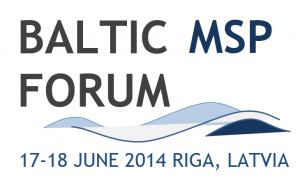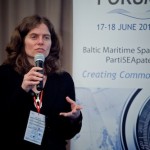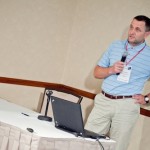 Workshop: Discussion on research needs for MSP
Workshop: Discussion on research needs for MSP
Moderator: Holger Janßen, Leibniz Institute for Baltic Sea Research
Presentations
- Robert Aps, Estonian Marine Institute, University of Tartu: GAP2 – Maritime Spatial Planning. Connecting science, stakeholder and policy, – download
- Marcin Rakowski, National Marine Fisheries Research Institute: Land-sea integration.What knowledge is necessary to bridge sea and land stakeholders. Case of small ports in PolandMarcin Rakowski, National Marine Fisheries Research Institute, Poland – download
- Riku Varjopuro, Finnish Environment Institute: Preliminary findings from the BALTWISE SEED project, Gulf of Finland- download
- Miina Karjalainen, Kotka Maritime Research Centre, TOPCONS project: Marine spatial planning tool for the conservation of marine ecosystems in the Eastern Gulf of Finland – download
- Kira Gee, University of Liverpool: Incorporating cultural ecosystem service into marine spatial planning: Identifying and mapping culturally significant sea areas – download
- Henn Ojaveer, Estonian Marine Institute, University of Tartu, BONUS INSPIRE project coordinator: Integrating spatial processes into ecosystem models for sustainable utilisation of fish resources – download
- Francois Bastardie, National Institute of Aquatic Resources, Technical University of Denmark: How spatial planning constrains cross-border fisheries: the bio-economic DISPLACE evaluation on the Baltic Sea – download
- Øivind Bergh, Institute of Marine Research Norway: Fisheries and Aquaculture integration – the COEXIST project – download
- Andrea Morf, University of Gothenburg: Evaluation of spatial planning as a s tool for integrated marine management: status, obstacles and research gaps – download
Workshop summary
Numerous research projects have been undertaken on MSP at European as well as national level using various funding programmes, for example FP7 and ESPON. The relevance of their results to the future development of MSP in the BSR was discussed as well as ways of how to facilitate a large research basis for MSP.
 Robert Aps, Estonian Marine Institute, University of Tartu: GAP2 – Maritime Spatial Planning – connecting science, stakeholders and policy
Robert Aps, Estonian Marine Institute, University of Tartu: GAP2 – Maritime Spatial Planning – connecting science, stakeholders and policy
Science needs transdisciplinary research. The context of MSP tends to be complex, uncertain and controversial and it cannot be adequately addressed based on the work done within the “linear” science-policy interface (SPI). It is believed that the way forward is to move towards a more participatory and “collaborative” SPI model. Mutual learning can happen through the adaptation process inherent in interaction and joint problem solving between science and society. The approach shall be “research to society”, instead of “research with society”. In the context of MSP, learning from ongoing planning processes is beneficial.
Marcin Rakowski, National Marine Fisheries Research Institute: Land-sea integration. What knowledge is necessary to bridge sea and land stakeholders? Case of small ports in Poland
The identified research needs include analysis of potential development of ports (by sectors: fishery, tourism, shipments, offshore), development of standards for minimum infrastructure requirements for the planned function of operational bases for the construction and service of wind farms, use of ports as local centres of economic development, and impact of new methods of use of marine space on reassignment of the coastal areas, i.e. consequences to the land.
It has been discussed that there is no significant research on economic development issues carried out so far, especially in comparison to studies in the field of environment. Different attitudes towards sustainable use of marine resources (preference given to immediate profit vs. a more sustainable use of fish stocks) can be observed in different coastal areas in Poland. These disparities can be explained with the specific historical experiences on the Eastern and Western coast of Poland.
Riku Varjopuro, Finnish Environment Institute, Environmental Policy Centre: Preliminary findings of BALTWISE SEED project
A ’next generation’ MSP project to be developed shall focus on transboundary planning and application of the ecosystem approach. The following issues needs to be tackled: How to organise effective, efficient and acceptable transboundary MSP? What are the legal challenges of transboundary MSP? How to analyse and evaluate the potential impact of MSP on sustainability of the Baltic Sea ecosystem services and the maritime economy? How to analyse and describe spatial effects of future developments in the Baltic Sea? What are the knowledge needs and best practices for applying the ecosystem approach to MSP?
For preliminary findings 13 projects – BaltSeaPlan, GAP2, AQUABEST, AQUAFIMA, PartiSEApate, BSR EastWestWindow, BaltCoast, PlanCoast, MASPNOSE, TOPCONS, TPEA, PlanBothnia, HELCOM Base, SUBMARINER as well as the GoF MSP pilot in Russian Barents Sea – have been reviewed. Processes and procedures of MSP have been developed and tested. Some challenges remain: data needs for MSP have been identified, but not all problems have been solved. The factor of economic development is addressed in few projects as environment issues are more prominent. Furthermore, the strategic planning aspect of MSP is not well developed. The ecosystem approach is still a difficult issue. Ecosystem services might be compatible with blue growth as the ecosystem approach is about managing humans and their activities.
Miina Karjalainen, Kotka Maritime Research Centre, TOPCONS project: Marine spatial planning tool for the conservation of marine ecosystems in the eastern Gulf of Finland
The aim of the project TOPCONS is to create and test a prototype GIS-based tool for MSP. The approach is to develop efficient measures to protect marine ecosystems, integration of ecological knowledge within formation about human pressures, use of interactive and clever technical solutions for interpreting the accumulated knowledge, communication of knowledge to the stakeholders. Datasets used by the project are: existing, available datasets (geology, biology, hydrography) and new data collected (modeled data about key species, birds and fish, information about the human pressures. stakeholder valuations).
Testing and adaptation of Bayesian Belief Networks (BBN) model to MSP will be done. The first version of the tool will include pre-selected human activities and their pressures, geological and hydrographical parameters defining the species distribution, probability of species distribution in the study area, changes in species presence/absence due to human pressures, location of protected areas and viewing possibility for original GIS and metadata sheets, stakeholder valuations. The next version will include species’ abundance, recovery of species after short term disturbance, further human activities and resulting pressures, socio-economical valuation of the areas, effects from the activities taking place in the drainage area. The model will be applicable to other areas with suitable background datasets. The final seminar of the project will be held in Helsinki on 25 November.
Kira Gee, University of Liverpool: Incorporating cultural ecosystem services into marine spatial planning: Identifying and mapping culturally significant sea areas
 A growing range of ecosystem, social, cultural and economic demands is placed on the sea by a growing range of stakeholders. Hence,different requirements for MSP can be observed. We need to get to know the resource, what are we dealing with (ecology, different sea values, goods and services), establish risks that new uses or cumulative impacts might bring to the resource and to goods and services as well as to set priorities for MSP/management.
A growing range of ecosystem, social, cultural and economic demands is placed on the sea by a growing range of stakeholders. Hence,different requirements for MSP can be observed. We need to get to know the resource, what are we dealing with (ecology, different sea values, goods and services), establish risks that new uses or cumulative impacts might bring to the resource and to goods and services as well as to set priorities for MSP/management.
The following research needs have been identified: Codifying cultural values for MSP purposes, how to describe cultural values, strengths and limits of concepts such as Cultural Ecosystem Services (CES), identification of marine places of socio-cultural importance, criteria for rating impacts on cultural places of importance, mapping cultural places of importance, identify techniques capable of delivering cultural values information in the spatial format required by planners.
Cultural values are preference-based values rather than social norms. In MSP they are place-based values. There is no universal classification or definition of cultural values and cultural ecosystem services is one way of framing cultural values. The concept of culturally significant areas, developed by ICES Workshop on Mapping Cultural Dimensions of Marine Ecosystem Services (WKCES) could be used.
ICES WKCES criteria for determining cultural significance are: cultural uniqueness, broad cultural/community reliance, importance of the feature to the resilience of the social-ecological system, degree of tradition, dramatic cultural change.
Topics on risk assessment, mapping of culturally significant areas, recommendations for data collection were addressed by the presenter, as well as a test case/project “Assessing the Cultural Significance of the Dart Estuary” (Devon, UK) briefly introduced.
Cultural values can be included in MSP. The concept of culturally significant areas is analogous to „ecologically significant areas“. There is no universal definition of cultural values as this is dependent on context and scale, importance of inclusiveness when determining culturally significant areas and the risks to them. A broad method, open to adaptation, should be applied and testing is required.
Henn Ojaveer, Estonian Marine Institute, University of Tartu, BONUS INSPIRE project coordinator: Integrating spatial processes into ecosystem models for sustainable utilisation of fish resources
 The recently started project INSPIRE addresses BONUS programme theme 3.3: “Improving stock assessments and resolving spatial heterogeneity and temporal dynamics of the Baltic Sea fish stocks”. It focuses on commercial fishing i.e. cod, herring, sprat and flounder, will fill in critical gaps in knowledge on the mechanisms of changes in spatial distributions of different life-history stages of fish (due to various drivers such as climate, fishing and species interactions). The impact of such changes on the structure and function of the Baltic ecosystem(s), the sensitivity and robustness of analytical fish stock assessment, particularly for flatfish are being researched. The project will answer the following questions: What habitat (both pelagic and benthic) conditions characterize the spatial distributions of cod, herring, sprat and flounder? To what extent do fishing and species interactions affect the local and basin-scale distribution of exploited stocks? What drives spatial connectivity and migrations of different fish species/populations? How does stock structure and separation of natural populations impact stock assessment outcomes? No new indicators will be created. The project will end in January 2018.
The recently started project INSPIRE addresses BONUS programme theme 3.3: “Improving stock assessments and resolving spatial heterogeneity and temporal dynamics of the Baltic Sea fish stocks”. It focuses on commercial fishing i.e. cod, herring, sprat and flounder, will fill in critical gaps in knowledge on the mechanisms of changes in spatial distributions of different life-history stages of fish (due to various drivers such as climate, fishing and species interactions). The impact of such changes on the structure and function of the Baltic ecosystem(s), the sensitivity and robustness of analytical fish stock assessment, particularly for flatfish are being researched. The project will answer the following questions: What habitat (both pelagic and benthic) conditions characterize the spatial distributions of cod, herring, sprat and flounder? To what extent do fishing and species interactions affect the local and basin-scale distribution of exploited stocks? What drives spatial connectivity and migrations of different fish species/populations? How does stock structure and separation of natural populations impact stock assessment outcomes? No new indicators will be created. The project will end in January 2018.
Francois Bastardie, National Institute of Aquatic Resources, Technical University of Denmark: How spatial planning constrains cross-border fisheries: the bio-economic DISPLACE evaluation on the Baltic Sea by
The DISPLACE project model-based approach (a spatial model of fisheries to help MSP) is aiming at modeling the interaction between fisheries and spatial dynamics. The project area covers a part of the Western Baltic Sea (Denmark, Sweden, Germany).
It is expected that MSP will narrow fishing routes. At the same time MSP requires empowering the fishing industry and managers with the right tools and knowledge to engage in MSP dialogues. Impact assessment of planned offshore windmills and nature conservation zonation in the Baltic Sea is conducted with the DISPLACE model-based approach.
The key messages are: Stable profit from compensations is possible even if opportunities for fishing are constrained. Some individual vessels are strongly affected while winners make profit to the detriment of others. Higher costs from increased steaming time are balanced out by higher revenue from healthier stocks and decreased energy efficiency. There is a positive global effect on stocks and concentration of effort towards high catch rate grounds. DISPLACE is a support tool for fisheries and management for facilitating understanding of dynamics, reproducing observed patterns and evaluating alternative scenarios.
Biological sustainability, sensitive habitats as well as landscapes identified by the BALANCE project are being considered by the project.
Øivind Bergh, project coordinator, Institute of Marine Research, Norway: Fisheries and Aquaculture integration – the COEXIST project
There are competing claims on coastal zones: aquaculture, fisheries, tourism, windfarms and wavefarms as well as marine protected areas. The COEXIST project was executed within EU 7FP and partners from the Baltic Sea region (Norway, Denmark, Germany and Finland.
The objective was to assess the existing spatial management tools for each case study and propose relevant improvements. Multi-criteria analysis was used and a multi- objective evaluation of marine spatial management of coastal zones was done.
For the economic success of aquaculture, diseases are the major problem in aquaculture, but by proper management they can be influenced.
It can be concluded that any spatially based management system will require input from all relevant stakeholders. Adaptive management can incorporate uncertainty as part of an evolving process. ICZM provides the framework for adaptive management. Adoption of human centred ecosystem approach is needed.
Guidelines for best practices in Maritime Spatial Planning to integrate fisheries, aquaculture and further demands in European Coastal Zones (http://www.coexistproject.eu/coexist-results/best-practices-guidelines) are developed by the project.
Andrea Morf, University of Gothenburg: Evaluation of spatial planning as a tool for integrated marine management: status, obstacles and research gaps
 The challenges in ICM and MSP are ecosystem sensitivity and growing pressures to the Baltic Sea, potential coastal & offshore conflicts, institutional complexity of countries with different priorities, political and administrative cultures, regulations & jurisdiction, instruments, responsibilities, various stages of developing MSP and ICZM.
The challenges in ICM and MSP are ecosystem sensitivity and growing pressures to the Baltic Sea, potential coastal & offshore conflicts, institutional complexity of countries with different priorities, political and administrative cultures, regulations & jurisdiction, instruments, responsibilities, various stages of developing MSP and ICZM.
In Sweden there is little practice of MSP in territorial waters, new legislation for EEZ and outer territorial waters is in place. EU Directives, pan-Baltic and Nordic institutions as well as global ones are external drivers for MSP. Evaluation of planning is important. There are no absolute values, but relative values (i.e. objectives). The whole chain, including process and impacts shall be evaluated. Guiding objectives for monitoring and evaluation are goal/indicator based approaches. The Open Standards methodology is being tested in Sweden.
Three draft reports (on literature, needs and synthesis report) are produced and will be discussed at expert meetings. The reports will be finalised by the end of 2014 and a scientific publication is planned.

